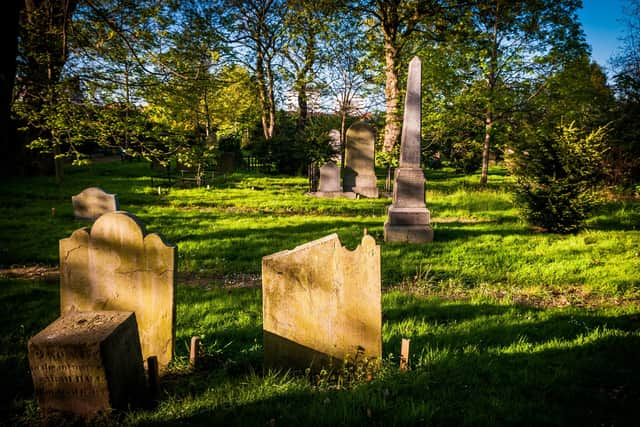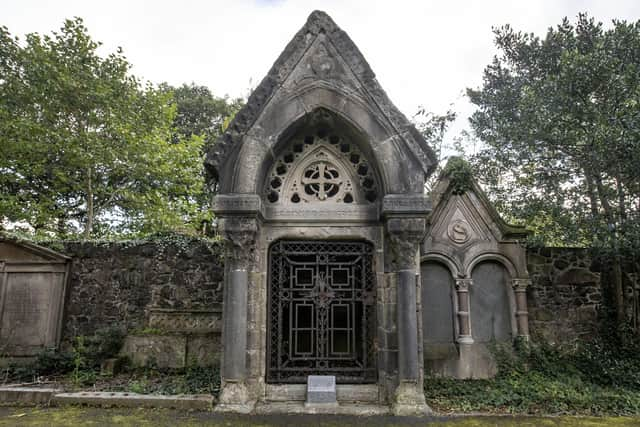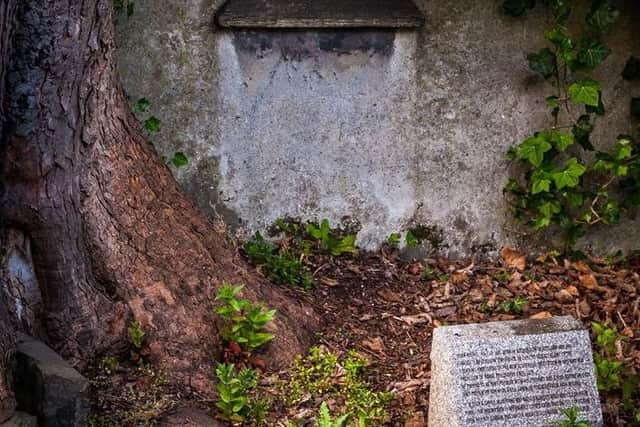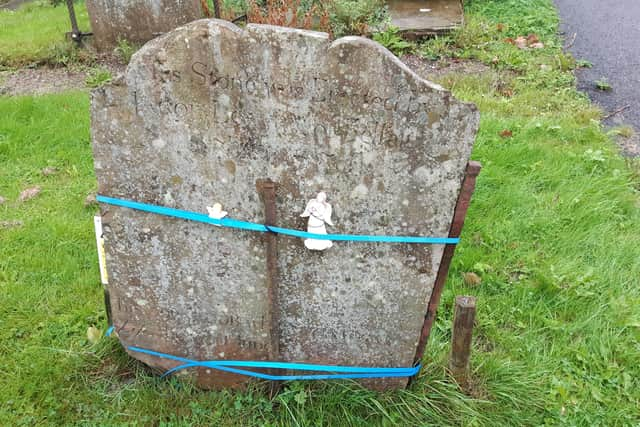Clifton Street Cemetery: people still leave trinkets at grave of nine-month-old boy who died in 1799
and live on Freeview channel 276
There was a time when shifty-looking people arriving at Clifton Street Cemetery would have been greeted with the barrel of a flintlock pistol, though thankfully I was more than 200 years too late to find such a welcome.
Instead I was greeted by Aaron McIntyre, a young historian from Clifton House, who gave me a guided tour of the burial ground. To the very best of my knowledge he wasn’t carrying any weapons.
Advertisement
Hide AdAdvertisement
Hide AdBefore we headed to the graveyard I looked at some of the items on display inside Clifton House relating to the cemetery which was opened in 1797.


Pointing at the large gun inside a display case, Aaron said: “That’s the flintlock pistol that was used to scare off bodysnatchers.
“In this period only the bodies of executed criminals could legally be used for medical research.
“The supply didn’t meet the demand so you had people going into the cemetery at night and digging up people’s loved ones and selling them to doctors. They shipped them over to Edinburgh and the British Isles.
Advertisement
Hide AdAdvertisement
Hide Ad“We only have one case that we know of a man called John Fairclough who was buried in Clifton Street who turned up in Warrington in 1828 in a barrel that was marked ‘salted pork’.


“We hired two night watchmen and gave them this flintlock pistol. They patrolled from dusk till dawn. Word got out quickly and there was very little activity after that.”
The archive at Clifton House dates back to 1752 and contains a vast quantity of information on the development of the Belfast Charitable Society and the city itself.
With the help of archive records Aaron was able to help put together a memorial inside Clifton House to all those people who were buried in unmarked graves.
Advertisement
Hide AdAdvertisement
Hide AdAaron said: “Most of these people, if not all of them – it’s the only record they ever existed. Births, deaths and marriages weren’t recorded, there were no headstones on their graves.”


Asked if such research gives him a connection to the past, Aaron said: “It definitely brings it to life. You have a name – this was somebody’s mother, father, son or daughter. Every person here has a story to tell, they’re part of our social history, our collective history.
“These were the workers who built Belfast up. It was institutions like ourselves, the poor house, who provided that safety net. There was no formal benefits system or anything like that. If you fell on hard times this was their only real option to come in here.
“There’s about 550 to 600 names on this memorial, these are just the ones we were able to find in our archive that were buried in unmarked graves. When you go into the other formal registration books from 1841 onwards we do record each burial.
Advertisement
Hide AdAdvertisement
Hide Ad“There’s estimated to be somewhere in the region of six to eight thousand people buried in unmarked graves. You are dealing with the different cholera epidemics in the 1830s and the famine in 1840 into 1850.


“It’s a story not often told in Belfast. When you think of the famine, you think of Connemara, of Skibbereen, or Cork, it really was on our doorstep as well.”
Inside the graveyard Aaron showed me the tombs of United Irishmen William Drennan and Henry Joy McCracken, whose story often overshadows that of his sister Mary Ann McCracken.
The Belfast Charitable Society are trying to put that right. Aaron said: “We’re aiming to bring her story to a new audience, through the tours, and we’ve republished a biography on her. We also are working on projects based on her legacy – what would she have been campaigned for if she was alive today.
Advertisement
Hide AdAdvertisement
Hide Ad“She dedicated the majority of her life to the poor at home and abroad. We’re looking at issues around modern day slavery and human trafficking. She was still standing down at the docks in Belfast at the age of 89 handing out antislavery leaflets.”
The Dunville family who were whiskey distillers have a mausoleum within the cemetery and another mausoleum belongs to James Luke, an American consulate in Belfast.
One of the most striking graves bears the inscription ‘YOUNG! moulders here 1829’. It belongs to John Young, a professor of moral philosophy.
Aaron said: “He is telling people that his empty shell is rotting in the ground.”
Advertisement
Hide AdAdvertisement
Hide AdAs one of the oldest graveyards in Belfast, Clifton Street Cemetery was the final resting place for thousands of people.
From those buried in unmarked graves, to the wealthy merchants who, even in death, showed off their wealth through elaborate memorials.
One of those men buried in the cemetery had escaped the slave trade twice.
Aaron explained how William Brown came to be in Belfast: “He came from Virginia in America. We did a bit of digging in the newspaper archives and found out he was a slave. He managed to get his freedom, settled down, had a wife and family, then slave prospectors came to his house, broke up his family, burnt his papers and sold them back into slavery.
Advertisement
Hide AdAdvertisement
Hide Ad“He was sold several times and ended up back down in New Orleans packing cotton on ships bound for the British Isles.
“One of the ships was coming to Belfast, he organised with the crew that he would stow away.
“He was arrested in Belfast as a stowaway but the magistrate said, ‘you walked into my court a slave but you leave here a free man’.”
People still leave trinkets at grave of nine-month-old boy who died in 1799
Advertisement
Hide AdAdvertisement
Hide AdIn terms of the engraved headstones in the cemetery, Aaron said the oldest went back to 1799.
“There were probably burials in the graveyard before that because it opened in 1797, but the oldest headstone we have with a date on it is 1799,” he said. “Unfortunately there’s been a lot of destruction in the cemetery over the years.”
The 1799 grave belongs to Jacob Lowry, who was nine months when he passed away.
Aaron said: “It’s quite unusual in this period to have such a young child commemorated. It’s not to say that their deaths didn’t matter, but in terms of the headstone inscriptions they didn’t tend to get one.
Advertisement
Hide AdAdvertisement
Hide Ad“It’s erected by Jacob Lowry in memory of Jacob Lowry. His name is at the bottom because there were more to be buried there.”
Asked why he thinks people continue to leave trinkets at the grave, Aaron said: “I think it’s just someone who is looking over the child.
“You’d have people come in here on tours who would know about this grave and they will just leave wee trinkets because it is the oldest headstone, it’s quite emotive that it was a child who was nine months old when he passed away.
“There’s something quite nice that people are still coming to the grave to leave things even if they aren’t related.”
Advertisement
Hide AdAdvertisement
Hide AdPaula Reynolds, chief executive of Belfast Charitable Society, said: “We opened the cemetery in 1797 in order to bury the dead from the Poorhouse. The cost of these burials was mostly funded by the charges placed on the wealthy who are buried there too. But wealth is not the only consideration, as it was also the resting place of many radicals and reformers from a time when Belfast was the Athens of the North, as well as industrial giants who helped to shape Belfast into a global powerhouse. It really does tell a vivid story of the time.
“We are delighted to be able to offer these tours again, as they are historically significant and help us to continue the work of the Society through the proceeds from ticket sales.”
Tours of Clifton Street Cemetery will run every Saturday and Sunday throughout October.
For tour times, prices and to book our cemetery tour or our house tour, visit cliftonbelfast.com/whats-on/tours
——— ———
A message from the Editor:
Advertisement
Hide AdAdvertisement
Hide AdThank you for reading this story on our website. While I have your attention, I also have an important request to make of you.
With the coronavirus lockdown having a major impact on many of our advertisers — and consequently the revenue we receive — we are more reliant than ever on you taking out a digital subscription.
Subscribe to newsletter.co.uk and enjoy unlimited access to the best Northern Ireland and UK news and information online and on our app. With a digital subscription, you can read more than 5 articles, see fewer ads, enjoy faster load times, and get access to exclusive newsletters and content. Visit https://www.newsletter.co.uk/subscriptions now to sign up.
Our journalism costs money and we rely on advertising, print and digital revenues to help to support them. By supporting us, we are able to support you in providing trusted, fact-checked content for this website.
Ben Lowry
Acting Editor